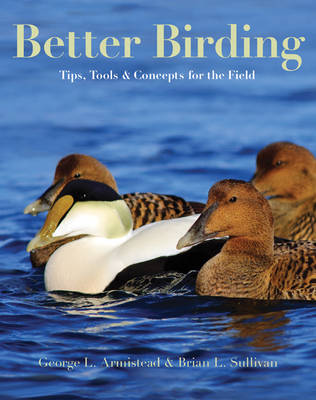By George L Armistead & Brian L Sullivan | Princeton University Press | Paperback | Dec 2015 | 360 Pages | 850 Photos | ISBN: 9780691129662

The Publisher’s View: Better Birding reveals the techniques expert birders use to identify a wide array of bird species in the field-quickly and easily. Featuring hundreds of stunning photos and composite plates throughout, Better Birding simplifies identification by organizing the birds you see into groupings and offering strategies specifically tailored to each group.
Skill building focuses not just on traditional elements such as plumage, but also on creating a context around each bird, including habitat, behavior, and taxonomy-parts so integral to every bird’s identity but often glossed over by typical field guides. Critical background information is provided for each group, enabling you to approach bird identification with a wide-angle view, using your eyes, brain, and binoculars more strategically, resulting in a more organized approach to learning birds.
Better Birding puts the thrill of expert bird identification within your reach.
The Authors: George L. Armistead is events coordinator at the American Birding Association and a research associate in the Ornithology Department at the Academy of Natural Sciences of Drexel University. He has led birding tours on all seven continents.
Brian L. Sullivan is eBird program co-director and photographic editor for Birds of North America Online at the Cornell Lab of Ornithology. He is the author of numerous papers on bird identification and the co-author of The Crossley ID Guide: Raptors and Offshore Sea Life ID Guide: West Coast.
Fatbirder View: I don’t really feel qualified to judge whether this book is all other reviewers say it is. It is certainly clearly written and well illustrated but I am not that familiar with the difficult to split North American birds to know if this book does the job. I found the whole section on wrens made it no clearer. To me, but that maybe my failure to comprehend, rather than the books failure to make it clear. When you have to split very similar looking birds by locality and call, to be told that there is an overlap of territory and little to distinguish many calls I’m stumped… and the authors seemed uncertain too.
Nevertheless, I do know from reading about some species shared across the Atlantic that much of the overall concept of each bird family is useful. Yes many fieldguides do not go into depth… but this is rather a large tome to be carrying out into the field. Birders would do well to revisit their way of going about identification and use all the information on offer rather than do what most of us do, rely on jizz and a handful of key features.
I am sure this will be an invaluable addition to any North American birders shelves to be studied after a day in the filed or before that trip to unfamiliar territory.
Buy this book from NHBSFatbirder
